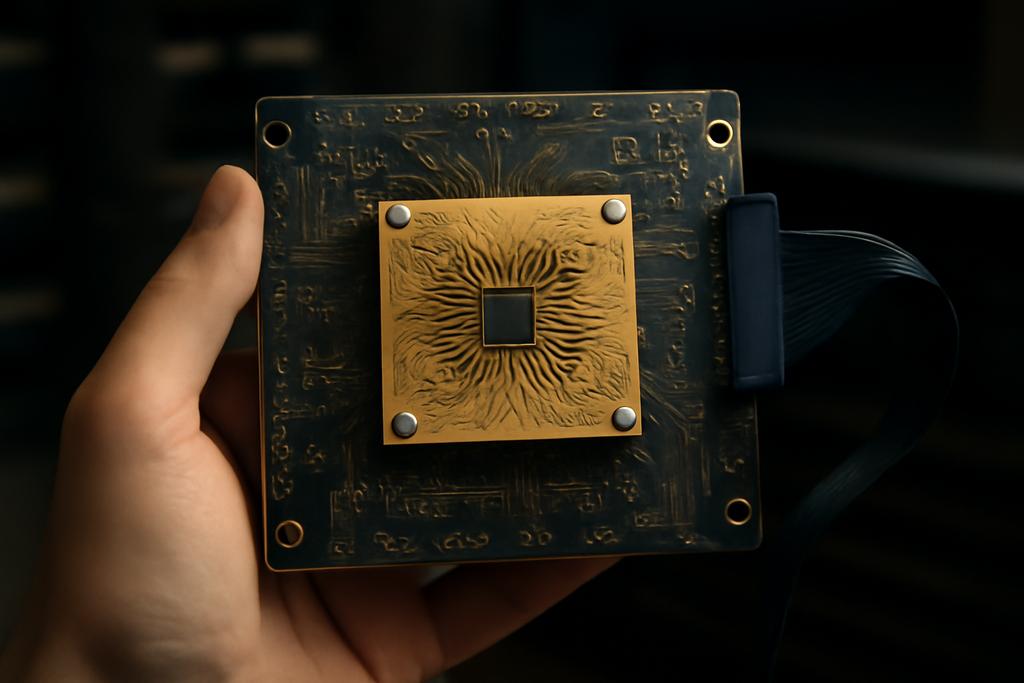Quantum randomness isn’t a magical trait tucked away in the bowels of a quantum computer. It’s something that emerges from how information weaves its way through a circuit. A team of researchers from The Netherlands, Germany, the United States, and Finland set out to test a bold limit: could very shallow quantum circuits—especially in a one‑dimensional layout—make themselves look Haar‑random across a handful of symmetry groups that matter in quantum information? The answer, they show, is nuanced, and surprisingly nuanced at that. The study, led by Lorenzo Grevink (QuSoft and CWI, Amsterdam) and Jonas Haferkamp (Saarland University), plus colleagues from the University of Cologne, Freie Universität Berlin, Caltech, and the University of Helsinki, maps out where the dream of shallow randomness glues itself to reality and where it simply cannot.
To a curious reader, the question might feel abstract. But it sits at the heart of how we benchmark quantum devices, how we understand the spread of information in quantum many‑body systems, and how we test ideas about randomness that underpin quantum simulations and even hints of quantum advantage. The authors study four mathematical groups that show up in quantum circuits: the Clifford group, the orthogonal group, the unitary symplectic group, and the matchgate group. Each represents a different flavor of symmetry and structure. Their central claim is a clean, architecture‑dependent statement: if your circuit’s lightcone—the set of qubits that can influence a given qubit in a few layers—is too small, then you cannot form unitary designs (or state designs) that mimic Haar‑random behavior for these groups. In practical terms: in a one‑dimensional world, you need circuit depth that scales with the system size to glue designs together in a meaningful way.
Yet the paper isn’t only about hard limits. It also reveals clever ways in which you can get near‑random behavior, at least for certain weaker notions of randomness, at logarithmic depths. And it shows that randomness can emerge differently depending on the exact group you’re asking about. The work stitches together deep mathematics with a storytelling about how information travels in quantum circuits, and it does so with a blend of rigor and human curiosity that makes the topic feel not only essential but almost cinematic in its implications.
What randomness means in quantum circuits
To talk about randomness in quantum circuits, researchers use a ladder of approximations. The ideal of Haar randomness is a uniform distribution over all possible unitary operations; it’s the gold standard of randomness, but it’s also intractable to realize exactly on any realistic device. So theorists study unitary k‑designs: ensembles of unitaries that mimic Haar randomness up to the k‑th moment. If you only probe the circuit with up to k copies of the same unitary, a k‑design looks indistinguishable from Haar randomness. There are related notions for quantum states called state designs, which describe how close the ensemble of states you can create is to drawing from a completely random (Haar) distribution over states.
The paper teases apart two flavors of approximation. Relative‑error designs require the design to replicate the Haar moment up to a small relative difference; additive‑error designs demand a looser, absolute bound on the difference. The distinction matters because it changes what depth you need in practice. And depth matters a lot when you’re trying to make a shallow circuit masquerade as a random tester for benchmarks or a simulator of chaotic quantum dynamics.
But there’s more to randomness than how close you are to Haar moments. The authors also explore anti‑concentration: a hallmark of Haar randomness is not just that averages match, but that a single realization’s behavior is spread out widely enough that you can’t predict its outcomes by looking at a few samples. For some groups, anti‑concentration holds in depth that scales with the system size; for others, it’s more stubborn and can fail even at logarithmic depths depending on how information threads through the circuit.
The no‑go bounds: depth that cannot be bypassed
One of the paper’s central messages is a family of no‑go theorems: for several natural groups, you cannot form even approximate short‑depth unitary or state designs unless the circuit’s lightcone is already spanning a constant fraction of all qubits. In plain language, if you keep your circuit shallow in a one‑dimensional chain, some of the random fingerprints simply won’t appear. This isn’t a vague intuition—it’s made precise with lower bounds that scale linearly with n, the number of qubits, for realistic one‑dimensional layouts. In all‑to‑all connectivity (where any pair of qubits can talk directly), the bounds relax to polylogarithmic (log n) depths, but they remain nontrivial: you cannot cheat depth by simply reordering gates in a highly connected graph either for many of the groups studied.
The first group studied, the Clifford group, is already known to be a 3‑design but not a 4‑design. The authors show that for Clifford unitary designs of order at least 4, any brickwork style circuit—think alternating blocks of gates across the chain—must have depth that scales with the system size in 1D. The argument is surprisingly direct: by constructing a special stabilizer‑mixed state and perturbing it on one qubit, they can reveal whether the circuit’s lightcone reaches across the whole system or remains quarantined around a small neighborhood. If the lightcone never touches a constant fraction of qubits, certain correlations simply cannot match the Haar baseline. The same theme carries over to the orthogonal and unitary symplectic groups, with subtle variations that reflect how these groups differ from the full unitary world.
When it comes to the matchgate group, which aligns with free‑fermion dynamics, the story is a touch different. The authors establish a lower bound that scales as roughly n1/3 divided by log n for anti‑concentration in a particular matchgate circuit model. As with the other groups, there’s a linear depth barrier for certain design notions, but the math behind matchgates is trickier because these circuits are more locally constrained, and their structure allows different routes to randomness. Taken together, the results sketch a landscape in which some kinds of quantum randomness stubbornly refuse to arise in shallow circuits, while others can creep in at modest depths under the right definitions and architectures.
Loopholes: additive‑error designs and log‑depth randomness
If the no‑go results say where you cannot go with shallow circuits, the paper’s second act shows where you can still sneak up to randomness in clever ways. A striking thread runs through the orthogonal, unitary symplectic, and Clifford groups: additive‑error state designs can be constructed in logarithmic depth in 1D, provided you restrict yourself to input states that satisfy a PPT condition (positive partial transpose) on every copy. The mathematical trick hinges on the fact that the Haar twirl over these groups looks the same as the Haar twirl over the full unitary group when you’re restricted to PPT inputs, up to a tiny additive error. By stacking two layers of locally random patches and then gluing them together, these constructions achieve log‑depth additive‑error state designs.
In other words, while you cannot glue full short‑depth designs in 1D for these groups, you can still generate meaningful randomized behaviour at depth that scales only logarithmically with system size, for the state designs and certain anti‑concentration measures. This is the sense in which randomness does “glue”—but only for a weaker notion of randomness and under careful, PPT‑constrained conditions. The paper shows that the gluing lemma from earlier work, which stitched together local randomness into global unitary designs, can be extended and refined to yield these log‑depth additive constructions for several groups.
There’s also a separate, deeply satisfying twist: the symplectic and orthogonal cases, when you frame the input states in PPT form, exhibit anti‑concentration in depth that scales only like log n. So even though full, strong designs remain out of reach at shallow depths, certain fingerprints of randomness still emerge quickly in a way that experimenters could, in principle, observe. The authors are careful to note that these results don’t automatically translate into a universal statement about all randomness in all tasks; rather, they reveal a nuanced boundary where the interplay between the group, the circuit geometry, and the type of randomness you measure matters a great deal.
Why this changes how we think about quantum experiments
The practical upshot is surprisingly concrete. If you’re using shallow quantum circuits to benchmark devices, to study chaotic dynamics, or to probe the limits of quantum advantage, you can’t treat all randomness as the same thing. The paper shows that randomness is architecture‑ and group‑dependent. In 1D, short circuits cannot reliably imitate Haar randomness for a wide swath of groups, which means that certain kinds of noise defenses, calibration tricks, or sampling tests will behave differently than you might expect if you assumed Haar universality across the board.
On the flip side, the log‑depth additions for additive‑error state designs imply that there are practical, scalable routes to generate a usable, though weaker, flavor of randomness. The PPT‑based equivalence between orthogonal/symplectic twirls and the unitary twirl at small additive error provides a concrete, testable recipe: you can get state designs with depth that grows only logarithmically with system size, opening a light‑path for experiments that want to explore randomized properties without resorting to deeply deep circuits. This matters for shadow estimation, benchmarking, and even certain randomness‑driven quantum simulations where you care about higher moments rather than every detail of the full distribution.
Another subtle takeaway is the role of the commutant—the mathematical space that commutes with your group’s action. The researchers exploit positive semidefinite operators in the commutant to connect observable outcomes with Pauli expectations. That bridge lets them turn a seemingly abstract group‑theoretic obstruction into something you can, in principle, test in the lab by measuring carefully chosen observables. It’s a reminder that behind the algebra, there’s a human story about how much you can learn from a circuit’s footprint with limited depth and limited reach.
Who did this and why it matters
The study is a collaboration anchored in The Netherlands, with the Dutch national center for quantum computing and simulation—QuSoft and the Centrum Wiskunde & Informatica (CWI) in Amsterdam—leading the charge. The authors include Lorenzo Grevink, Jonas Helsen, and colleagues from Saarland University, the University of Cologne, Freie Universität Berlin, Caltech, and the University of Helsinki, among others. The paper places a bow on a line of work that began with the idea that random quantum operations might be approximated by shallow circuits, and asks what happens when you apply that idea to groups that are not the full unitary group.
At the heart of the project are a handful of researchers who push the boundary between mathematical rigor and physical intuition. The lead authors—Lorenzo Grevink and Jonas Haferkamp—are joined by Markus Heinrich, Jonas Helsen, Marcel Hinsche, Thomas Schuster, and Zoltán Zimborás, among others. The results are not just a collection of theorems; they’re a map of a landscape that many quantum hardware builders and theorists have to navigate: where can we rely on randomness, and where must we be careful not to mistake patchwork for a global, Haar‑like random state?
In short, the paper reframes a familiar question—how random is randomness in quantum circuits?—into a nuanced, architecture‑aware answer. It shows that the onset of randomness in shallow circuits is real, but subtle. It’s not a single universal rule; it’s a family of rules that depend on the symmetry group you care about, the geometry of your device, and the exact notion of randomness you’re aiming for. For scientists and engineers building the next generation of quantum devices, that clarity is both humbling and empowering: it tells you where your intuitions from Haar randomness will carry you, and where you’ll need to be more careful, or more cunning, in how you design experiments and interpret results.








